REVISITING DISNEY: ATLANTIS
Welcome to Revisiting Disney! This week, we’re looking at a Disney movie that, personally, is one of my favorites, Atlantis: The Lost Empire!! Like always, I have labeled each category so if you want to skip to the parts that interest you most, feel free. And, of course, if you have any thoughts, burning or otherwise, please share in the comments!
BACKGROUND OF ATLANTIS: THE LOST EMPIRE
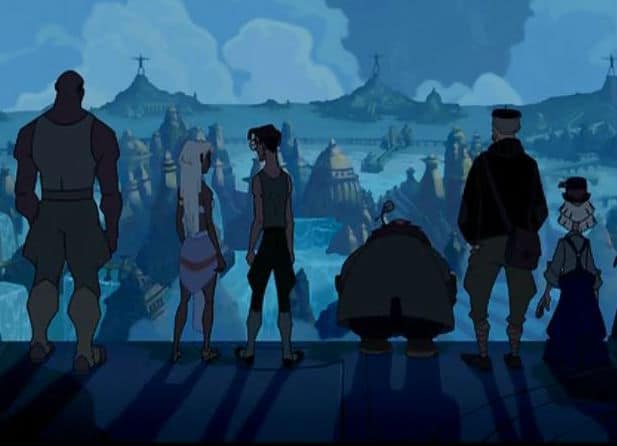
Photo: Disney
Released on June 15th, 2001, Atlantis: The Lost Empire is a different sort of Disney movie. On the audio commentary, directors Kirk Wise and Gary Trousdale and producer Don Hahn (the team behind Beauty and the Beast and Hunchback of Notre Dame) talk at length about the fact that the film is an action adventure and drew more from that action/adventure genre than other Disney films had at the time.
Additionally, there are no talking animal characters in the film. Although originally Milo had a pet rat that served as his animal sidekick, the character was cut because the overall feel of the film was too different; the direction team thought that the animal sidekick was too much of a Disney trope, so they decided to let the nerdy scientist tell his own story.
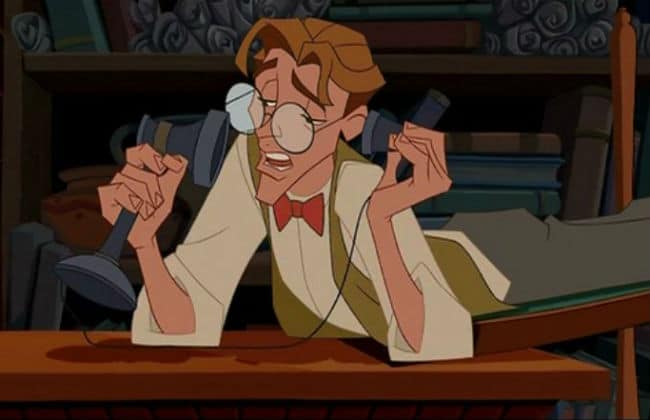
Photo: Disney
Atlantis: The Lost Empire is different for a few other reasons. The lead character, Milo Thatch, wears glasses and is a cartographer/linguist/archaeologist, the Princess Kida (Kidagakash) is the first Disney princess to become a queen by the end of her own movie, this was the last movie role of Jim Varney (the voice of Cookie), and Dr. Joshua Sweets is one of the first African-American characters to have a major role in a Disney movie.
MUSIC
James Newton Howard served as the orchestrator/score producer/composer for Atlantis: The Lost Empire, and it shows. Howard is known for using multiple chord progressions, lots of key changes, and false cadences (a cadence is the sequence of notes or chords that end a musical piece, so a false cadence is a fake ending, like The Return of the King). He had previously worked on the music for Disney’s Dinosaur, and like in that movie, the score is epic. It builds when the action does, and Howard is very good at manipulating the emotions of his audience through the score. It’s subtle but works wonderfully. As far as Disney scores go, it’s one of my favorites.
ANIMATION
Because Atlantis: The Lost Empire is based on action/adventure stories, there are lots of callbacks to that style of filmmaking. There are several transitions between scenes that are done with the wipe; a simple line that shifts replaces the old scene with the new one. The direction team, in the audio commentary, talks about this as a callback to old films stylistically. Since the film is an action/adventure epic set in 1914, this works beautifully.
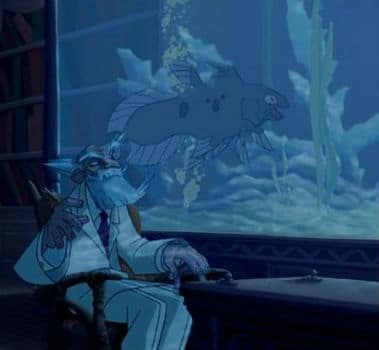
Photo: Disney
Although the style is calling back to old effects, there are many innovative moments in this film. One effect that the team mentions specifically is the subtle use of the ripple patterns from Whitmore’s tank (they also mention that the fish in the tank were coelacanths, which would not be confirmed to be alive until the 1930s, but that since Whitmore is an eccentric billionaire who collects artifacts and finances expeditions for these artifacts, the idea that he had found a few of this fish fits his personality).
The submarine scenes were very complicated and technologically complex. The initial reveal was shot using phoplane, where they took a traditional background and shifted it slightly. Producer Don Hahn called this shot 2.5D because it wasn’t 2D or 3D, but somewhere in the middle.

Photo: Disney
The sub-drop, one of the longest shots in the film, lasts about a minute and the team points out that this shot is not only gorgeous but that it also highlights the different technologies used in Atlantis. The sub itself is 3D, using the spinning techniques that were used in the ballroom scene of Beauty and the Beast, marrying the 2D character of Milo with the 3D sub and other characters. Also, some of the bubbles were hand-drawn while others were computer animated. Finally, the fight scene with the Leviathan is one of the set pieces of the film, using a fully CGI monster for that. It was a very elaborate character and had to interact with the 2D elements in the film (I think it looks great).
PLOT
Atlantis: The Lost Empire opens with a quote by Plato about the sinking of the island of Atlantis, and shows the audience the sinking of Atlantis through the eyes of little Princess Kida. The queen is called up to a blue light that covers the city while it is submerged.
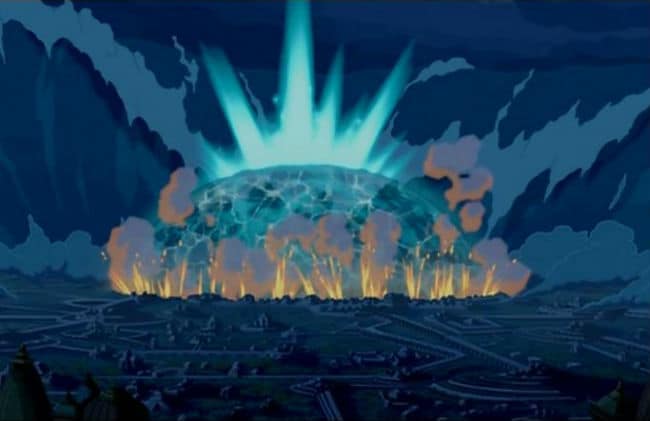
Photo: Disney
The main body of the movie, however, is set in 1914 and follows the adventures of Milo, a cartographer/linguist/plumber who is trying to convince the museum he works at to fund his expedition to Iceland to find the Shepherd’s Journal, which is the key to finding the lost continent of Atlantis and their amazing power source.
Milo is crushed when the museum refuses to fund his expedition, but he is brought to the home of Preston Whitmore, an eccentric billionaire who knew his grandfather. Whitmore has the Shepherd’s Journal, and, since he made a promise to Milo’s grandfather, funds the expedition to find the lost city of Atlantis.
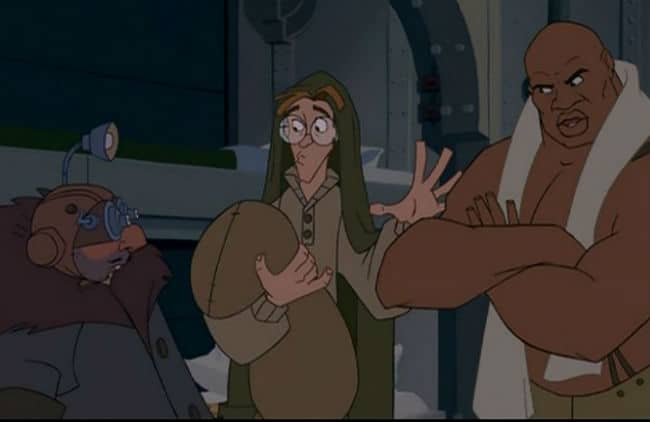
Photo: Disney
Whitmore has assembled a wonderful cast of characters to explore the lost city, including the young female mechanic Audrey, the big and burly doctor with a heart of gold Sweets, the cranky receptionist Mrs. Packard, the demolition expert who was busted out of prison Vinnie, the bad cook Cookie, geologist/dirt whisperer Mole, and their commanders, the unflappable Rourke and the no-nonsense Helga.
Troubles plague the expedition before they finally arrive at the lost city, with living Atlantians, including Princess Kida, who is concerned about the future of her people. As she and Milo learn from each other, the audience gets the feeling that all is not right, and that Rourke might be more than just a benevolent leader.

Photo: Disney
As the action rises, there are several questions the film needs to answer. Does the power source that Milo is looking for actually exist? How did Atlantis survive, again? Can Atlantis be saved from ruin? Will Milo find his place in the world? Will everyone live happily ever after? (I mean, it’s a Disney movie, so odds on happiness are pretty strong, but there is some doubt, sprinkled in with a ton of explosions and lots of action).
SOURCE MATERIAL
When it comes to source material, Atlantis: The Lost Empire is a little tricky, mostly because it’s not based on one legend. The use of the quote from Plato is the main source and where the legend originated, but the commentators point out that, like in the film, the legend of the lost continent of Atlantis is one that stretches across multiple cultures. Atlantis is seen today as an idealized and Utopian society with advanced technology, but in some of Plato’s writings, Atlantis was made up of people obsessed with world domination.
There were floods and volcanic eruptions that destroyed civilizations in the Mediterranean, and so there might be a basis in fact, but no one is sure (actually, science is pretty sure it’s a myth, but I am optimistic that it is just hanging out with King Arthur and the Loch Ness Monster). The film was also inspired by the works of Jules Verne, Edgar Rice Burroughs, and H.G. Wells, classic adventures.
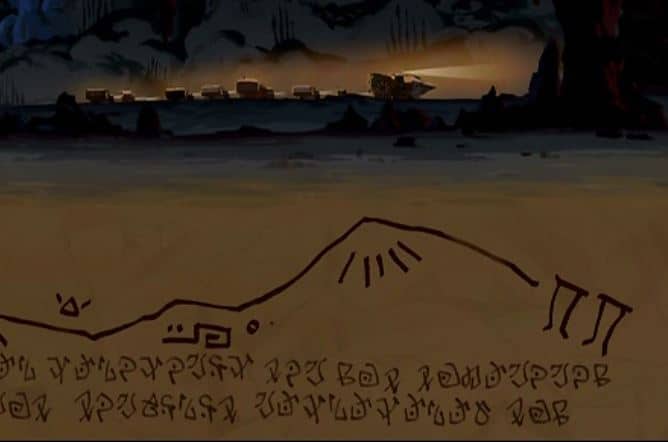
Photo: Disney
Marc Okrand created the Atlantean language and had previously created two languages for “Star Trek,” Vulcan and Klingon. The written Atlantean language was designed to be read left to right, then right to left, then left to right again; it was a different direction for each line. The idea is that it looks more water-like, and it’s a neat effect.
The setting of the film in 1914 was chosen because it was, as the producer said, a crossroads. 1914 is pre-World War I, a time when the industrial revolution and the agrarian society were starting to run into each other, there was a feeling of optimism and a sense of exploration that the team felt was unique to that year. They also said 1914 was a good contrast to the was modern enough, technology-wise, but still far enough in the past to be a bit more “once upon a time” like.
The 2000’s
At this point in the new millennium, things are progressing very similarly to how they were when we looked at The Emperor’s New Groove. Things will change drastically for the next film, but in June of 2001, things are still new. Technologies are changing rapidly, and there are new things being introduced every day. Microsoft 2000 was released, AOL and Time Warner merged, The London Eye opened, the Mars Odyssey launched, and many other technological advances colored the new millennium.
“Survivor” debuted, and Harry Potter and the Goblet Fire was released, and Gladiator, X-Men, How the Grinch Stole Christmas!, What Women Want, and Erin Brockovich all were popular films. The discovery of Alexandria in Egypt probably influenced Atlantis: The Lost Empire, in that it was a discovery of a place long thought lost that held a ton of knowledge.
Despite all the positive advances, the new millennium also held its fair share of earthquakes, fires, a plane crash in Paris, and there is an environmental disaster in the Mississippi (300 gallons of black sludge). So, like many other years, it was a mix of good and bad.
LESSONS LEARNED
The first lesson from Atlantis is that you can’t judge a book by its cover. In Atlantis, the scrawny and smart guy is the hero, the thugs stand up for what’s right, and the characters who are typically the good guys were the villains.
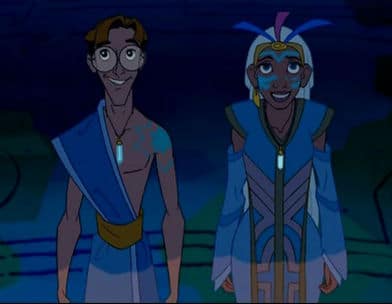
Photo: Disney
Secondly, don’t be afraid to chase your dreams. Milo is afraid to chase his dream, but when he does, he finds himself on the adventure of a lifetime and in a position to change his world.
Thirdly, knowledge is power. Milo is the only person in the world who can read Atlantean, and that means that he can help Kida and her people preserve their culture and learn things that they’ve forgotten.
DOES IT HOLD UP?
There’s a lot to love in Atlantis: The Lost Empire, from the groundbreaking technology and animation to the wonderful score and the risks taken in the story. Since this movie came from the team that brought us Beauty and the Beast and The Hunchback of Notre Dame, this isn’t a surprise. There are, however, some problems in the film, mainly in that the story can feel a little confusing at times. There’s a lot happening, and it can feel a little contrived at times. Since it’s an action/adventure story, however, I think that, overall, it works.
For next week: Lilo & Stitch
If you enjoyed this post and the others in the Revisiting Disney series, and have found yourself wishing that you could find them all in one convenient and bound book with eight extra essays, there is an option for you! Check out A Journey Through Disney: My Look Back Through Disney Canon, now available on Amazon as both a Kindle book ($4.99) and a paperback ($11.99).
OTHER SOURCES:
https://thewaltdisneycompany.com/about-disney/disney-history
http://www.imdb.com
http://studioservices.go.com/disneystudios/history.html
http://www.thepeoplehistory.com
http://www.livescience.com/23217-lost-city-of-atlantis.html
Bailey, Adrian. Walt Disney’s World of Fantasy. Everest House Publishers. New York, New York. 1982.
Finch, Christopher. The Art of Walt Disney: From Mickey Mouse to the Magic Kingdom. Harry N. Abrams, Inc. New York, New York. 1975.
Johnston, Ollie and Frank Thomas. The Disney Villain. Hyperion. New York, New York. 1993.
Thomas, Bob. Disney’s Art of Animation From Mickey Mouse to Hercules. Hyperion. New York, New York. 1992.
ARE YOU A ROMANCE FAN? FOLLOW THE SILVER PETTICOAT REVIEW:
 Our romance-themed entertainment site is on a mission to help you find the best period dramas, romance movies, TV shows, and books. Other topics include Jane Austen, Classic Hollywood, TV Couples, Fairy Tales, Romantic Living, Romanticism, and more. We’re damsels not in distress fighting for the all-new optimistic Romantic Revolution. Join us and subscribe. For more information, see our About, Old-Fashioned Romance 101, Modern Romanticism 101, and Romantic Living 101.
Our romance-themed entertainment site is on a mission to help you find the best period dramas, romance movies, TV shows, and books. Other topics include Jane Austen, Classic Hollywood, TV Couples, Fairy Tales, Romantic Living, Romanticism, and more. We’re damsels not in distress fighting for the all-new optimistic Romantic Revolution. Join us and subscribe. For more information, see our About, Old-Fashioned Romance 101, Modern Romanticism 101, and Romantic Living 101.

